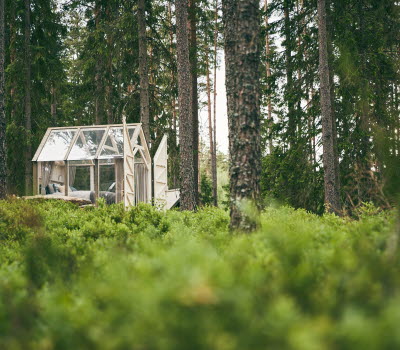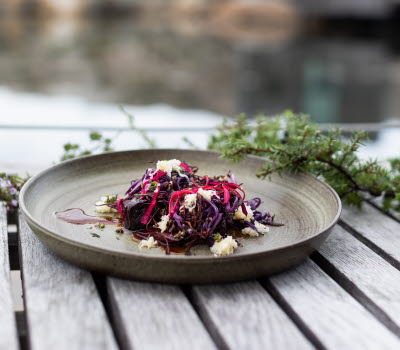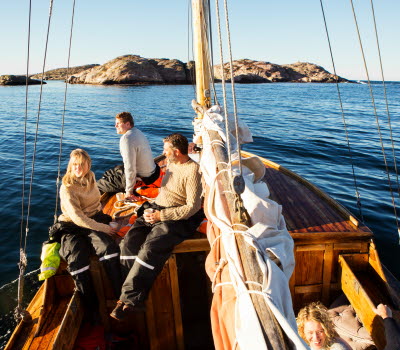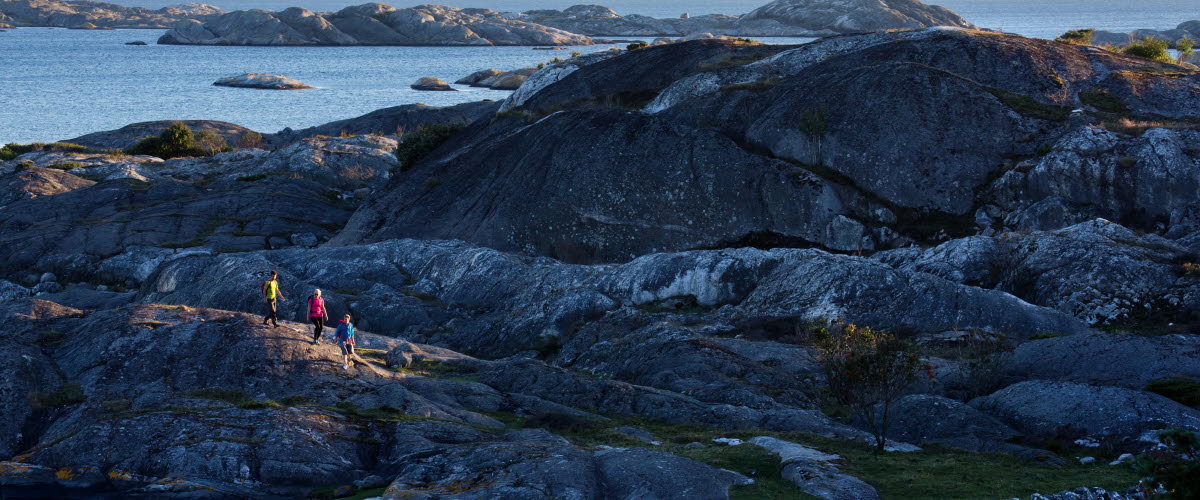Seasonal holidays and breaks in West Sweden
- Pål Johansson
Come and see countless cranes take to the dance floor at Hornborga lake in a hooping, whooping frenzy. Holiday like a Swede, west coast-style, toe dipping in the azure waters and lolling on sun-heated rocks. Or why not arrive when autumn does to catch the lobster premiere and crack open the black gold of the west coast? Winter – come and celebrate a real Swedish festive season in urban cool Gothenburg, with a soothing glass of glögg in one hand and a sticky cinnamon bun in the other at a Christmas market.
The arrival of spring
The days are getting longer…and warmer as spring arrives in West Sweden, usually by mid-March. It’s Mother Nature’s way of telling us to get outside and enjoy the light; grab a coffee street-side and watch the streets and squares filling up. Spring is the perfect time of year for cycling and walking trips in West Sweden’s great outdoors.
Photographer: Roger Borgelid
Spring favourites
Spring is in the air – as the old saying goes – and so is the scent of wild garlic on the forested slopes of Kinnekulle mountain. Kinnekulle is a riot of colours, buds, blooms and new life in spring as the forest floor gives up its harvest of wild garlic – come and forage for some. Another sign that spring has come is the arrival of thousands of long-legged, long-necked cranes that come to dance at Hornborga lake. There are no wallflowers here – they all dance to nature’s tune to the delight and fascination of the 150,000 people stacking the vantage points around the lake to watch.
Photographer: Jonas Ingman - M2B AB
Nature works its wonders too further west in the waters off the Bohuslän coast. The shellfish season is in full swing so why not celebrate by joining the crew of a local fishing boat to harvest the langoustine, oysters and mussels off the coast. April 1st is not only April Fools Day (yes, they have it in West Sweden too) it is also heralds the start of the sea trout fishing season on the coast. And the good people of Gothenburg and holidaymakers have a reason to celebrate this day – this is when the restaurants and cafés of the city spill out on to the streets to offer their kerb-side eats and drinks.
Musts
Spring is also when some of West Sweden’s biggest attractions open up for business; Liseberg amusement park in Gothenburg, the Göta Canal and zoo Nordens Ark are just three. Always open for business is the small town of Alingsås, the café and fika capital of Sweden. Fika is the Swedish word for coffee or tea break – and, as we all know, Swedes are mad about coffee, preferably accompanied by buns and biscuits. In Alingsås you can go on a fika tour of some of the town’s best cafés and learn all about this uniquely Swedish tradition.
Photographer: Jonas Ingman @ Bruksbild
A newer tradition in West Sweden is the start of the art tours season when you can visit galleries and even the artists themselves in their studios around the region.
Weather
It’s spring, the weather is changeable and it’s wonderful. Temperatures in spring can nudge +20C, but it can also get very cold.
What to bring
- Walking boots
- Sunglasses
- Binoculars
- A warm jumper
Summer
Summer days are longer in West Sweden, averaging about 3 hours more daylight (often sunlight) than mainland Europe. More time then to be beside the seaside, or a lake. Head for the coast, hop on a boat and find yourself a deserted island for diving from the rocks, swimming and generally doing nothing.
Photographer: Jonas Ingman
Or doing something and getting out and about in the region for our summer festivals and events. After all, you have three extra hours every day to enjoy them!
Summer hits
It’s the simple things in life that count. Like preparing a picnic, hiring bikes, cycling down to the harbour and catching a ferry to one of the car-free, carefree islands off the coast. Or, if you are visiting the town of Smögen on the coast, grab yourself a bag of legendary smoked prawns from a local fishmonger, sit on the rocks and watch the sun go down. It will be back up again soon enough – this is West Sweden – the summer days are long. How about a foodie road trip starting at the Norrkvarn lock on the Göta Canal, via inland farm shops and food producers and way out west to the Weather Islands where you can sample the freshest fish and shellfish you have ever tasted.
Family holiday? Kids getting cranky? Head for Skara Sommarland Water and Amusement Park, near the town of Skara, or Liseberg amusement park in Gothenburg.
Musts
Let’s get you off on the right foot if you are the outdoors type. West Sweden is criss-crossed by well planned and signed walking and hiking trails that take you through and to our famous beauty spots and landscapes; the Bohuslän coast, the hills and plains of Västergötland, and the forests and myriad lakes of Dalsland.
Photographer: Roger Borgelid
You can use the same trails to discover the region by bicycle, for example, cycling the towpath of the 190-km long Göta Canal. Sea kayaking is a wonderful way of exploring the islands off the coast, while canoeing is the mode of transport for discovering the waterways and lakes of Dalsland.
Photographer: Roger Borgelid
If you want to take your canoeing to the next level how about Scandinavia’s biggest canoeing event, Dalsland Kanot Maraton+?
Weather
Mid-may sees the arrival of summer in West Sweden and the days are long. The sun does set, but not for very long. The average temperature in the July-August period is around +16C (hot for Sweden) with daytime temperatures often climbing into the +20C-+25C region.
What to bring
- Swimwear
- Flip-flops
- Sunglasses
- Walking boots
- A good book
Autumn
The heat of summer gives way to the milder temperatures of autumn around the beginning of October. It’s a wonderful time to explore and discover West Sweden on our walking and cycling trails and, off the coast, you have the place almost to yourself. Autumn time means foraging time in the forest – bring a basket and harvest the mushrooms and berries.
There’s harvesting going on around Lake Vänern too – of the fish roe variety – and known as ‘Vänern gold’ enjoyed on crispy toast. This time of year, to mark the end of summer, people throw crayfish parties. Really. They even bait them and tempt them from their river hideouts with fishy morsels, boil them and accompany them with lashings of schnapps. Come and join the party. The first Monday after 20th September is a special day along the west coast. It is the start of the lobster fishing season when the boats go out from the coastal town and village harbours to bait, pot and hopefully haul a load of the black gold. You can join in all of these activities.
Musts
Harvest festivals, art tours and local food markets all offer their own taste of West Sweden. Join us for our Michaelmas celebrations, or go nocturnal arty at the ‘Art night’ in the town of Falköping, one of the biggest cultural events in the region.
Weather
The mercury starts to go south at the beginning of October to around +5C-+10C. Winds on the coast begin to pick up as the rain comes in.
What to bring
- Rain gear
- Wellington boots
- Outdoor clothes
- Picnic basket
Winter
A winter break at a countryside estate feasting on a West Sweden Julbord at Christmas time? Dinner for two sampling Scandi-cuisine at one of the many fantastic restaurants in Gothenburg? And if the snows come you can enjoy white clad West Sweden on our ski slopes or try cross-country skiing and trip skating.
Winter fun
If we get a ‘real winter’ you can hit the slopes and cross-country ski tracks at ski resorts Billingen in Skövde town, Ulricehamn Ski Centre in Ulricehamn town and Mössebergsbacken in the town of Falköping. If you haven’t tried trip skating West Sweden is the place to do it when the waterways freeze over.
Photographer: Roger Borgelid
Winter kayaking – yes, with the right clothes and equipment that is. It’s on offer along the coast and out to the islands. Let’s put it this way – you and your friends will have the entire archipelago for yourselves. This time of year Gothenburg is a sight for sore eyes, when it literally lights up with a million lights at the Liseberg amusement park. Brighten up the winter darkness by visiting the Lights light festival in the town of Alingsås; it also doubles as the fika (Swedish for coffee or tea break) capital of Sweden with its more than 30 cafés.
Photographer: Liseberg
Musts
Our selected and certified ‘Taste of West Sweden’ restaurants are worth a trip – any time of year. And you can combine eating well with treatments and massages at our spa hotels. Join in the festive spirit in West Sweden when we celebrate Saint Lucia day on 13th December and visit one of our famous Christmas markets for a glass of glögg and a giant cinnamon bun.
Weather
Winter in West Sweden is milder but wetter than more northern climes in Sweden, at least along the coast. The average temperature is around zero to -2C.
What to bring
- Warm clothes
- A warm hat
- An umbrella








